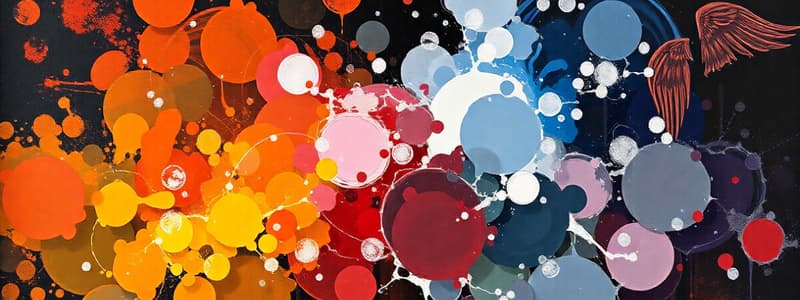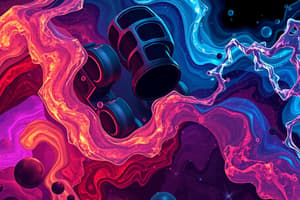Podcast
Questions and Answers
What is the main difference between heterogeneous and homogeneous mixtures?
What is the main difference between heterogeneous and homogeneous mixtures?
- Heterogeneous mixtures are formed by chemical reactions, while homogeneous mixtures are formed by physical processes.
- Heterogeneous mixtures have components that are visible, while homogeneous mixtures have components that are not visible. (correct)
- Heterogeneous mixtures are always solids, while homogeneous mixtures can be liquids or gases.
- Homogeneous mixtures are always liquids, while heterogeneous mixtures can be solids, liquids, or gases.
Which of the following is an example of a suspension?
Which of the following is an example of a suspension?
- Milk
- Air
- Salt water
- Mud (correct)
Which of the following is a chemical property of matter?
Which of the following is a chemical property of matter?
- Density
- Color
- Melting point
- Flammability (correct)
Which of the following is NOT a characteristic of a chemical reaction?
Which of the following is NOT a characteristic of a chemical reaction?
Which of the following is an example of a pure substance?
Which of the following is an example of a pure substance?
What is the difference between an element and a compound?
What is the difference between an element and a compound?
Which of the following is a property of a substance that can be observed without changing the substance's chemical composition?
Which of the following is a property of a substance that can be observed without changing the substance's chemical composition?
What is the difference between WHMIS and GHS?
What is the difference between WHMIS and GHS?
Flashcards
Mixture
Mixture
A combination of two or more pure substances.
Homogeneous Mixture
Homogeneous Mixture
Looks the same throughout; separate components are not visible.
Heterogeneous Mixture
Heterogeneous Mixture
Different components are visible and can be separated.
Solution
Solution
Signup and view all the flashcards
Chemical Reaction
Chemical Reaction
Signup and view all the flashcards
Physical Properties
Physical Properties
Signup and view all the flashcards
Chemical Properties
Chemical Properties
Signup and view all the flashcards
Pure Substances
Pure Substances
Signup and view all the flashcards
Study Notes
Mixtures
- A mixture is a combination of two or more pure substances.
- Mixtures can be either homogeneous or heterogeneous.
Homogeneous Mixtures
- Appear the same throughout.
- Components are not visible.
- Examples include solutions like saltwater or air.
Heterogeneous Mixtures
- Appear different throughout.
- Components are visible.
- Three types:
- Mechanical mixtures: Visible different substances, e.g., soil, pizza.
- Suspensions: Different states of matter mixed, e.g., muddy water.
- Colloids: Similar to suspensions but the suspended substance cannot be easily separated, e.g., milk, aerosols, paint, blood.
Solutions
- Components are not visible.
- One substance is dissolved in another.
- Examples include air and pop.
Pure Substances
- All particles are identical.
- Have constant chemical and physical properties.
- Two types:
- Elements: Cannot be broken down further, found on the periodic table.
- Compounds: Chemical combination of two or more elements in a specific ratio, e.g., H₂O (water).
Matter Properties
-
Properties describe how a substance behaves.
-
Physical properties describe appearance and composition, e.g., color, melting point, conductivity.
-
Chemical properties describe a substance's reactivity, e.g., color change, formation of new compounds, heat release.
-
Chemical change occurs when new substances with different properties are formed, and energy is either released or absorbed.
-
Signs of a chemical change include:
- Heat production or absorption.
- Consumption of starting materials.
- Color changes.
- Formation of new substances.
- Gas bubbles or precipitate formation.
- Difficult to reverse.
- New odors.
- Light production.
Studying That Suits You
Use AI to generate personalized quizzes and flashcards to suit your learning preferences.




